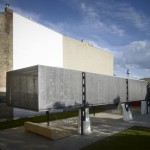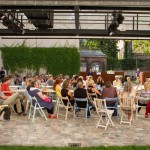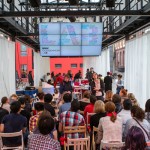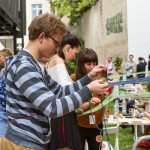The urban life exploration lab has moved from America to Europe, proving to be a model of public dialogue and active participation.
After the BMW Guggenheim Lab New York cultural project was launched in New York last summer, the mobile lab came to Berlin where it ran from 15 June to 29 July. The open-air pavilion designed by Atelier Bow-Wow (which was presented in Zeppelin #98) is hosted in one of the inner courtyards of a former 19th century beer factory: the Pfefferberg complex in the Prenzlauer Berg district (Schönhauser Allee 176).
The site looks actually like an urban hotchpotch mixing together buildings of various heights (from one to several storeys) interspersed with an accessible, but intricate network of public and semi-public courtyards, now turned into terraces for restaurants and cafes. The location of the loft in one of the available courtyards was aimed at assuring its coherent functioning in the larger context of postindustrial conversion (in the former factory work spaces, among other commercial spaces – restaurants, cafes, hostel – there are located now the famous Aedes Pfefferberg center of architecture and ANCB Metropolitan Laboratory, partner of BMW Guggenheim Lab project). In fact, for many of the events included in its programme, the pavilion, with its open sides on the ground floor level (protected only by mobile curtains) allowed for spatial expansion and thus the courtyard was used to accommodate the crowds of visitors.
At least five reasons of appreciation
As already stated in the first article dedicated to this topic, the BMW Guggenheim Lab project runs in two-year cycles and during each cycle the pavilion will travel to three cities around the globe. As part of this first cycle, New York and Berlin will be followed by Mumbai, the project thus envisaging contact with three very different urban cultures. The general theme of the first cycle is “Confronting Comfort”, and it explores citizens’ participation to city development. With the support of BMW Group Romania, we had the opportunity to participate to several of the events organized in Berlin, which will be separately presented in the Smart Systems section. We would further like to make a few general observations about this second stage of the event.
The first refers to the transcultural motivation (with reference to the presentation made by philosopher Wolfgang Welsch): the first sign of a valid urban culture is a motivated reaction to the contemporary urban challenges that result in a change of the aesthetic conditions. The events were attended by an enthusiastic public and we could see that the young generation of Berlin is extremely concerned not only with the recent transformations of the capital, equally spectacular and controversial, but also with the urbanity outside the German borders.
Secondly, we much appreciated the significance of the site and its accessibility: the Magma Architecture team was the local team invited by the pavilion’s creators to select the site and to obtain the necessary authorizations; the location chosen reflects thus both an occupation opportunity and an extremely current urban issue, namely the status of vacant sites in urban policies, as well as the issue of temporary interventions on such sites.
The third reason why BMW-Guggenheim’s initiative is praiseworthy (the largest cultural project of the brand) is the high level of interactivity and participation characterizing the event: all workshops, discussions and presentations included in the programme had free access and direct participation to dialogue was encouraged. Energized by the on-line forum, the event was characterized by a spirit of active participation, as well as by exquisite presentations made by speakers with a solid academic career and/or practical experience acknowledged internationally.
The fourth issue is particularly valuable for architects, through the questioning of professional discipline, of the way in which we practice today and of the tools and resources that could be developed in the future for architecture. In that scenarios occurred during the round tables (especially in the debate between Joseph Grima, editor of Domus magazine, and Carlo Ratti on participatory design / open source design) role of the architect is that of a curator or editor who has the ability to put together and combine things received from colleagues from other areas. This is a very exciting role, which opens new ways of working and has the chance to re-invent the profession.
Finally, the fifth reason of admiration was the multi-, inter- and transdisciplinary character of the lab. Everybody understood that cities can not develop by individual gestures, but through a collective effort which requires transcultural policies, critical discourses, an efficient organization and moreover coherent objectives. The issue of knowledge (“how” we think about the urban concept) and the theory of urban action were at the core of the debates, along with concrete urban interventions during the entire programme.
A programme dedicated to contemporary social challenges
Going back to the programme, emphasis was laid on the urban changes related to infrastructure, technology and sustainability. The Berlin team coordinated by the Guggenheim curator, Maria Nicanor, proposed over 100 events organized on the site of the loft and elsewhere in the city. The first theme entitled “Empowerment Technologies” (15–24 June), under the guidance of José Gómez-Márquez – an innovator in health technologies – grouped together a series of “do-it-yourself” workshops aimed at changing urban space. The second theme, “Dynamic Connections” (27 June – 06 July), dedicated to urban mobility and sustainability was coordinated by Rachel Smith – main transport planner with AECOM Brisbane, Australia. Corine Rose – a Berlin artist and psychologist – proposed the third theme entitled “Urban Micro-Lens” (07–18 July) dedicated to discussions on the controversial Berlin land policy and on the interaction between psychology, architecture and art. The lab led by Carlo Ratti at Massachusetts Institute of Technology in Boston coordinated the forth and last theme of the calendar – “SENSEable City” (19-29 July) on temporary architecture and exploring the way in which technology is involved in transforming the social life of the city. Separate articles will be dedicated to this programme in the Smart Systems section of our next issues.
In-between presentations, urban explorations, guided tours and pedestrian workshops, BMW-Guggenheim Lab joined the social networks in order to widen the call for urban actions dedicated to the future of the cities, animated by innovating ideas. In conclusion, the lab proved to be a real melting pot of ideas and new practices related to the life of cities and attracted over 27.000 visitors in only 33 days.
www.bmwguggenheimlab.org







